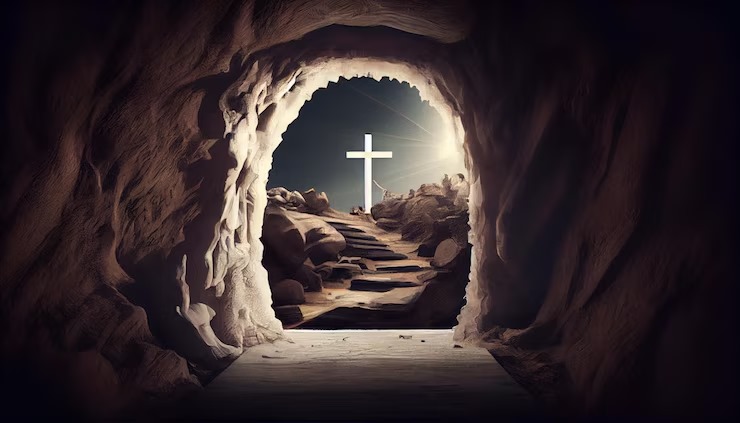Throughout the annals of time, no week holds as profound a significance as the Week of our Lord’s Passion and Resurrection. Its gravity is rivalled only by the Week of Creation, marking it as a pivotal moment on God’s redemptive calendar. This primer endeavours to illuminate the sequence of events that transpired two millennia ago, urging us to reflect on the transformative journey that Easter encapsulates.
Palm Sunday
As the Week commenced, Jesus made a triumphant entrance into Jerusalem amid the resounding cries of “Hosanna!” His arrival atop a humble donkey symbolized the fulfilment of Messianic prophecy, igniting hope and anticipation among the people. This initial moment marked a promising beginning, with Jesus poised to accomplish the ultimate act of salvation for His people. The atmosphere was electric as the City recognized Him as the long-awaited King, fulfilling the prophecy of Zechariah 9:9. Yet, as the Week unfolded, the atmosphere within the City would undergo a dramatic shift, foreshadowing the tumultuous events to come.
• Scriptural References: Matthew 21:1-11; Mark 11:1-11; Luke 19:28-44; John 12:12-19.
Monday to Wednesday
As the initial excitement of His triumphal entry subsides, Jesus sets about preparing the stage for His ultimate glorification. On Monday, Jesus initiates His mission by cleansing the Temple, which had deviated from its sacred purpose of being a House of Prayer, as mentioned in Isaiah 56:7, to become a den of robbers. The once vibrant fanfare begins to dim, overshadowed by the sobering reality of Jesus’ confrontations with the religious authorities, gradually intensifying the atmosphere. On Tuesday, Jesus cursed a barren fig tree, hinting at the impending narrative of judgment and consequences on God’s people, who in the Old Testament are often symbolically depicted as figs or a fig tree (Hosea 9:10; Jeremiah 24). Throughout this period, Jesus imparts profound teachings through parables, underscoring the imperative of repentance, faith, and obedience for attaining salvation. Amidst these developments, a lingering question arises: can the situation deteriorate any further?
• Scriptural References: Matthew 21:12-25:46; Mark 11:12-13:37; Luke 19:45-21:38.
Thursday
This day marks the pinnacle of solemnity in the Holy Week. While much of Jesus’ ministry has unfolded in public settings, on this day, He turns His focus to His disciples in a deeply profound manner, culminating in the intimate gathering known as the Last Supper. During this sacred meal, the disciples remain unaware of the spiritual forces at play, even as Jesus, aware of the betrayal to come, quotes from Psalm 41:9; signalling the meticulous unfolding of God’s sovereign plan. It is during this meal that Jesus institutes the Lord’s Supper, a profound symbol of the impending sacrificial death He was to endure as the Paschal Lamb. It was also at this time that Jesus humbly washed the feet of His disciples, demonstrating the selfless love and servanthood that epitomized His ministry. As the evening progresses, the weight of the impending sacrifice is palpable, culminating in Jesus’ agonizing prayer in the Garden of Gethsemane. Here, the Son of God submits fully to the will of His Father, laying the foundation for the redemption of the elect. The scent of blood is as thick as ever as Jesus prepares to fulfil His mission.
• Scriptural References: Matthew 26:17-56; Mark 14:12-52; Luke 22:7-53; John 13:1-18:1.
Good Friday
As the coils of the serpent tighten, victory appears elusive. From a human vantage point, all hope seems lost, exemplified by Peter’s impulsive attempt to intervene forcibly. Judas’ betrayal, sealed with a kiss, ushers in a sequence of five distinct trials—both religious and secular—as authorities interrogate the Son of Man. Before the pseudo-king Herod Antipas, the fulfilment of Isaiah’s prophecy unfolds as Jesus, resembling a silent lamb led to slaughter, refrains from defence. Led to Golgotha, the hill of crucifixion, the Lamb of God endures six agonizing hours upon the cross. There, he drank the cup of God’s wrath and, though sinless, bore the weight of sin itself. The apex of redemption arrives as the Suffering Servant echoes the Psalmist’s lament, “My God, my God, why have you forsaken me?” The viper’s strike pierces his hands and feet; he is surrounded by mocking dogs and encircled by a band of villains. Those who gaze upon him, the one they have pierced, mourn bitterly, their sorrow akin to that of an only child or a firstborn. The Author of Life is laid to rest among the wicked donated by Joseph of Arimathea. How can the death of one man suffice to atone for the sins of many?
• Scriptural References: Matthew 26:57-27:66; Mark 14:53-15:47; Luke 22:54-23:56; John 18:1-19:42.
Holy Saturday
The cacophony of chaos simmers down. The exuberance of the triumphal entry and the fervour of teaching in the Temple now feel like distant memories. Silence reigns supreme within the confines of the tomb—a Sabbath unlike any before. Just as God rested after completing His work of creation, so too does Jesus rest, following the fulfilment of His salvific mission. A created stone is used to seal up the Rock of Ages. Yet amid the stillness, anticipation builds as the dawn of the greatest day in history approaches…
• Scriptural References: Matthew 27:57-66, Luke 23:50-56
Easter Sunday
Christ, the Son of God, emerges victorious over the shadowy dominion of death, neither abandoned to the abyss nor succumbing to decay. His Resurrection stands as the cornerstone of the Christian faith, a resplendent affirmation of His emphatic triumph over Sin and Death. In this divine act, God’s redemptive design is unveiled, showcasing His sovereign authority to vanquish death’s grip and extend the promise of New Life to all who would believe in the Son.
Through the Resurrection, Jesus substantiates His divine identity and affirms His role as the conduit of eternal life for believers. As He emerged from the tomb, so too are we, united with Him in His Resurrection, elevated to heavenly realms in Him. This historic event stands as the linchpin of salvation, a resounding declaration that the Battle has been decisively won.
As the apostle Paul affirms, the Resurrection is not a peripheral doctrine but the very essence of faith. Without it, our faith would be futile, and we would remain ensnared in the bondage of sin. Yet, through the Resurrection, we are infused with a Living Hope—a hope that transcends the temporal confines of this life and extends into eternity.
In the words of our Glorious Lord, Jesus Christ: “I am the Resurrection and the life. Whoever believes in me, though he die, yet shall he live, and everyone who lives and believes in me shall never die.” This profound invitation beckons us to run to Christ and receive the transformative power of the Resurrection and anchor our hope in the eternal promise it embodies.
Do you believe this?
• Scriptural References: Matthew 28:1-20; Mark 16:1-20; Luke 24:1-53; John 20:1-21:25.


